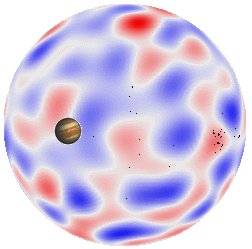Difference between revisions of "AY Honors/Weather/Answer Key"
| (16 intermediate revisions by the same user not shown) | |||
| Line 1: | Line 1: | ||
| − | + | A '''convection cell''' is a phenomenon of [[fluid dynamics]] which occurs in situations where there are [[temperature]] differences within a body of [[liquid]] or [[gas]]. | |
| − | + | Fluids are materials which exhibit the property of [[flow]]. Both gasses and liquids have fluid properties, and even particulate solids such as flour, sand and gravel can behave as fluids. When a volume of fluid is heated, it expands and becomes less dense, and thus more buoyant than the surrounding fluid. The colder, more dense fluid settles underneath the warmer, less dense fluid and forces it to rise. Such a movement is called a [[convection]] current. | |
| − | + | A rising body of fluid typically loses heat because it encounters a cold surface, because it exchanges heat with colder liquid through direct exchange, or in the example of the earth's [[atmosphere]], because it radiates heat. At some point the fluid becomes more dense than the fluid underneath it, which is still rising. Since it cannot descend through the rising fluid, it moves to one side. At some distance its downward force overcomes the rising force beneath it and the fluid begins to descend. As it descends, it warms again through surface contact, conductivity, or compression, and the cycle repeats itself. (The heating through compression of descending air is what is responsible for such welcome winter phenomena as what is known in Western North America as a [[chinook]] or in the Alps as a [[foehn]].) | |
| − | |||
| − | + | A pattern of this type is called a '''convection cell'''. Convection cells can form in many kind of fluid situations, including the Earth's atmosphere, boiling water or soup (where the cells can be identified by particles they transport, such as rice), the ocean or the surface of the sun. | |
| − | |||
| − | + | The size of a convection cell is largely determined by the fluid's properties, and they can even occur when the heating of a fluid is uniform. | |
| − | + | <!--this picture is wrongwrongwrong, but leave it here for the code. I am tracking down copyright-free images to go here--> | |
| − | + | <div style="float:right; margin-left:10px; margin-right:10px; width:300px; text-align:center"> [[image:convection cells and jupiter.jpg]]<br> <small>''Convection cells on the Sun <br>with Jupiter superimposed'' <br> </small> </div> | |
| + | The [[Sun]]'s [[photosphere]] is composed of '''convection cells''' called granules, columns of superheated gas each approximately 1000 kilometres in diameter, hottest in the center (5800 degrees Celsius) with cooler gases falling in the narrow spaces between them. | ||
| − | + | ===External links=== | |
| − | http:// | + | * [http://www.solarviews.com/eng/edu/convect.htm Jet Propulsion Lab description of convection cells] |
| − | + | * [http://www.mountainnature.com/Climate/Chinook.htm Mountainnature.com - Chinook] | |
| − | |||
| − | http:// | ||
| − | |||
| − | |||
| − | |||
| − | |||
Revision as of 22:28, 6 January 2004
A convection cell is a phenomenon of fluid dynamics which occurs in situations where there are temperature differences within a body of liquid or gas.
Fluids are materials which exhibit the property of flow. Both gasses and liquids have fluid properties, and even particulate solids such as flour, sand and gravel can behave as fluids. When a volume of fluid is heated, it expands and becomes less dense, and thus more buoyant than the surrounding fluid. The colder, more dense fluid settles underneath the warmer, less dense fluid and forces it to rise. Such a movement is called a convection current.
A rising body of fluid typically loses heat because it encounters a cold surface, because it exchanges heat with colder liquid through direct exchange, or in the example of the earth's atmosphere, because it radiates heat. At some point the fluid becomes more dense than the fluid underneath it, which is still rising. Since it cannot descend through the rising fluid, it moves to one side. At some distance its downward force overcomes the rising force beneath it and the fluid begins to descend. As it descends, it warms again through surface contact, conductivity, or compression, and the cycle repeats itself. (The heating through compression of descending air is what is responsible for such welcome winter phenomena as what is known in Western North America as a chinook or in the Alps as a foehn.)
A pattern of this type is called a convection cell. Convection cells can form in many kind of fluid situations, including the Earth's atmosphere, boiling water or soup (where the cells can be identified by particles they transport, such as rice), the ocean or the surface of the sun.
The size of a convection cell is largely determined by the fluid's properties, and they can even occur when the heating of a fluid is uniform.
The Sun's photosphere is composed of convection cells called granules, columns of superheated gas each approximately 1000 kilometres in diameter, hottest in the center (5800 degrees Celsius) with cooler gases falling in the narrow spaces between them.

